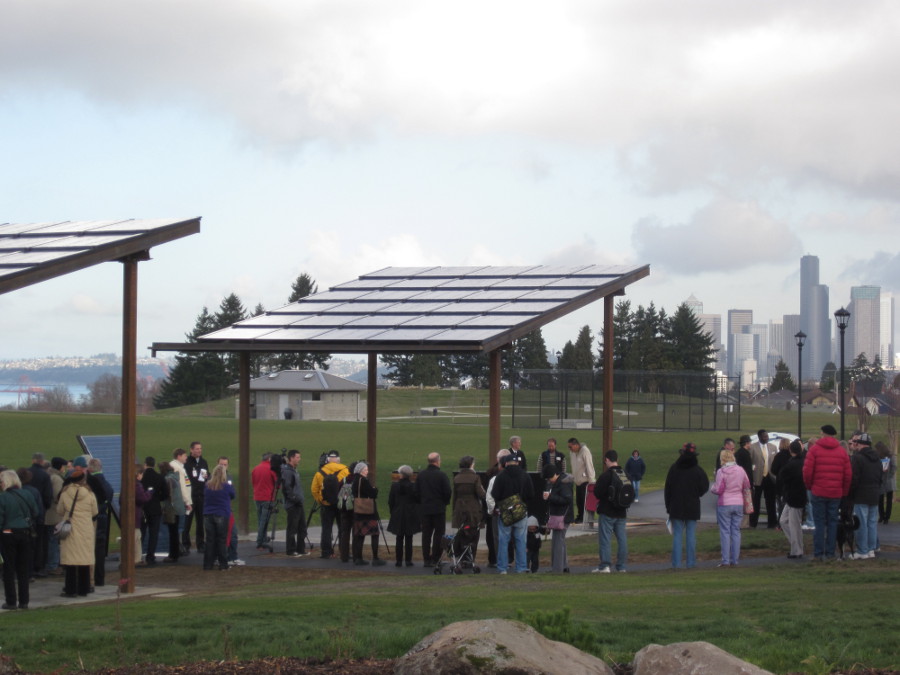March 21, 2012


Just don’t see solar panels fitting on your roof? They can still be installed into your energy future, thanks to community solar programs. “Community solar is a way for multiple individuals to share in the benefits of a single solar installation,” explains a publication from the National Renewable Energy Laboratory (NREL). Instead of investing in a private solar energy system, people can pool their resources to develop a large-scale solar energy project for the benefit of a group or neighborhood.
<![CDATA[
[nggallery id=133 template=carousel images=8][imagebrowser id=133]
By Debbie Van Der Hyde
Just don’t see solar panels fitting on your roof? They can still be installed into your energy future, thanks to community solar programs.
“Community solar is a way for multiple individuals to share in the benefits of a single solar installation,” explains a publication from the National Renewable Energy Laboratory (NREL). Instead of investing in a private solar energy system, people can pool their resources to develop a large-scale solar energy project for the benefit of a group or neighborhood.
Community solar projects remove common barriers to using solar as a renewable resource, including customer inertia due to the potential complexity of choosing photovoltaic panels, finding a vendor, and acquiring permits. Community solar also allows apartment and condo dwellers, as well as homeowners who live in shaded areas, to participate in domestic energy generation.
However, the biggest benefit for most people is cost savings. Private solar installations can be costly (although the price is decreasing) and community solar offers an alternative for Sierra Club Green Home readers to participate without investing a significant amount of money upfront. Instead, participants typically pay for shares into the program and qualify for net-metering savings to match.
The concept is quickly gaining momentum across the nation as people experiment with different business models to bring solar energy systems to their cities and towns. One innovative approach comes from Solar Mosaic, a financing platform that connects investors to solar projects in their communities.
“We utilize ‘crowdfunding’ to democratize the financial and environmental benefits of solar…everyone [can] take part in the solar rooftop revolution,” says Billy Parish, president and co-founder of Solar Mosaic.
One of the organization’s recently funded projects, The Asian Resource Center, is expected to save more than $100,000 over its 20-year lease, which they can reinvest in programs that provide low-income housing in Oakland, CA.
To build awareness, Solar Mosaic also organized Community Solar Day on November 20, 2011.
“We partnered with 20 organizations, [including Sierra Club], to hold a day of action for people to kick start their community solar projects,” Parish says.
The efforts included an online toolkit, small community solar grants, and a MeetUp.com page to help people make local connections. Approximately 127 communities from around the world participated, and Solar Mosaic awarded two community solar grants—one in India, the other in Minneapolis. Plans are being made now for Community Solar Day 2012.
Other community solar models include:
A successful example of this utility approach comes from Seattle which, despite its rainy reputation, was designated a Solar America Community (one of 25 across the nation) by the US Department of Energy in 2008. On March 21, Seattle City Light unveiled a 24-kilowatt community solar project: three new solar picnic shelters located at Seattle’s Jefferson Park.
“Given the growing interest in community solar, this was a great opportunity for a legacy project that also provides our customers with more choice in conservation and renewable energy programs,” says Jack Brautigam, renewable energy program manager for Seattle City Light.
According to Brautigam, the utility could have chosen any site within its service territory for the project. However, in the spirit of community solar, Seattle City Light wanted to make the project as accessible as possible (hence the public park). The photovoltaic panels, manufactured by Silicon Energy in Washington, are translucent and serve as the roofs of the shelters, allowing the sun to shine through.
Seattle City Light received a $300,000 grant from the Department of Energy to develop the customer-supported community solar installation, which the utility matched in program expenditures to plan, design, and market.
To date, Seattle City Light has sold more than 400 of the 500 units to customers for $600 per unit (with a max of two units per customer), in return for Washington state production incentives and energy credits on participating customers’ power bills.
“Revenues from customers participating in the initial project will be used to plan and build a second project, serving as a revolving funding mechanism,” Brautigam says.
In the second phase, Brautigam adds that Seattle City Light plans to install an educational interface near the picnic shelters to help people learn more about the viability of solar energy.
We at Sierra Club Green Home are truly heartened to see these community models that make solar energy more practical and accessible.